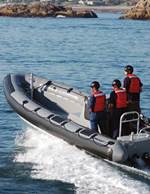Integrated software: Streamlined hull & tool design
Although its reputation was solid, rigid inflatable boat (RIB) builder Planatech (Athens, Greece) recently sought ways to design new composite products and their corresponding tool sets faster, without compromising quality.
Although its reputation was solid, rigid inflatable boat (RIB) builder Planatech (Athens, Greece) recently sought ways to design new composite products and their corresponding tool sets faster, without compromising quality. Toward that end, Planatech incorporated CATIA software from Dassault Systèmes (Vélizy-Villacoublay, France) into its design process. The “integrated” software, which includes CATIA Analysis and CATIA for Composites, enabled the company to start with the boat’s basic hull design, using surface modeling capabilities, then design the entire structure and assembly in three dimensions, says Planatech’s technical director Angelos Protopsaltis. “We were able to do away with our old development procedures, which were solely based on an engineer’s know-how, and accelerate our development process for new boats by 25 percent.”
A RIB (boaters pronounce it “rib”) has a rigid hull that is fitted, at the gunwale (the top edge of the hull sides), with an inflatable tube (see end note). Planatech makes its inflated tubes from several plastic sheets seamed together, which are now more efficiently cut to final shape using the “unfolding surface” capability built into CATIA. The software also includes a Composites Materials library with material specifications, which allows more consistent composite material layups for the hull structure. Finally, the CATIA package includes CATIA Analysis, so that virtual structural analysis can be performed without resorting to building prototypes for destructive testing, saving time and resources (see the lower photo at left). Plus, after the boat design is frozen, tooling also can be designed. Moreover, the software can generate the numerical control (NC) codes and seamlessly transfer them to the company’s routers to cut polyester foam or wooden masters for the hull tooling.
Concludes Protopsaltis, “Thanks to CATIA Analysis, we no longer need to create detailed prototype hulls for testing, since we can perform accurate stress tests virtually. We can implement innovative design ideas faster and have reduced our overall production time by 30 percent.”
Read more about RIBs in CT's feature coverage of RIB manufacturing in "Composite rigid inflatable boats adapt for hard work, safe play," under "Editor's Picks," at right.
Related Content
-
Plant tour: BeSpline/Addcomp, Sherbrooke, QC, Canada
Composites automation specialist increases access to next-gen technologies, including novel AFP systems and unique 3D parts using adaptive molds.
-
Damage tolerance testing of sandwich composites: The sandwich CAI test
A new ASTM-standardized test method established in 2022 assesses the compression-loaded damage tolerance of sandwich composites.
-
Corebon induction heating
This sidebar to CW’s August 2024 feature article reviews this technology for more efficient composites manufacturing and why it aligns with Koridion active core molding.



